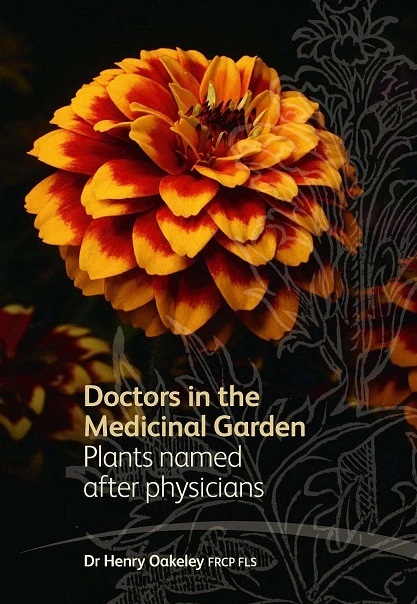
A new book from the Royal College of Physicians (RCP) commemorates the lives of doctors – dedicated, amazing, diverse and often ephemeral. Some who travelled the world enduring great privations and even shipwreck in the search for new species of plants; others who wrote herbals, proposed ludicrous doctrines or made revolutionary discoveries, built cities, fought in forgotten wars, dissected eyeballs or made book illustrations by covering flowers with printer’s ink and pressing them onto the page. They all have one thing in common; they have plants named after them.
The names of many of our familiar garden plants have fascinating origins, and are linked with medical figures from three millennia of history, from the Greeks and Romans up to the twentieth century. Lavishly illustrated with full-page photographs, the book is a remarkable tour-de-force, intertwining medical and botanical history.
Doctors in the Medicinal Garden; Plants named after physicians is authored by Dr Henry Oakeley, the garden fellow of the Medicinal Garden of the Royal College of Physicians. The garden contains 1,300 plants connected with medicine or medical figures. Dr Oakeley selects 59 plants commemorating the astonishing lives of doctors who advanced the cutting edge of the science, botany and horticulture of their era. Many took part in overseas expeditions, braving shipwreck, famine and disease in the pursuit of science:
Dr Clarke Abel (Abelia x grandiflora) was shipwrecked and attacked by pirates on returning from an abortive ambassadorial mission to meet the Emperor of China, losing all his seed samples…
Dr J R Carmichael (Aconitum carmichaelii), a missionary who assisted an opium trader to collect botanical specimens in China on behalf of Kew Gardens. He died of fever caught from his patients in the hospital he set up to deal with the great famine in northern China in 1877…
Dr Peter Cormack Sutherland (Greyia sutherlandii) was ship’s surgeon on HMS Sophia, which was frozen into the ice in Assistance Bay all winter in 1851. He emigrated and ended up designing cities in Natal, South Africa...
In addition to the personal stories of these great doctors, the RCP gardener, Clare Beacham, describes how to grow the plants and Dr Oakeley unravels their historical medicinal use, with cautionary notes about present-day usage:
On Rudbeckia fulgida (orange cone flower from North America): 'The Cherokee and the Iroquois used it to treat intestinal worms, but it is alarming to see that it is still being recorded on internet sites as a treatment for intestinal worms in children.'
Dr Oakeley writes:
Our Medicinal Garden is a fascinating place, and all the plants have their own stories. The ones in this book are about doctors who have plants in our Garden named after them, from Euphorbus (the spurges – Euphorbia) who was physician to King Juba II (who married the daughter of Anthony and Cleopatra) and his brother Musa (the bananas – Musa) physician to Caesar Augustus the first Roman Emperor, to ‘the good pastor Stephen Hales [Halesia carolina, the snowbell tree] who weighed moisture in a pair of scales, to lingering death put mares and frogs, and stripped the skin from living frogs’ and in so doing was the first man to measure blood pressure in animals and sap pressure in plants. He also discovered how to stop the pastry sagging in a pie dish. This book is not just for Christmas (or doctors or gardeners, although it makes a good present) but a source of information - and I hope amusement - to all.
